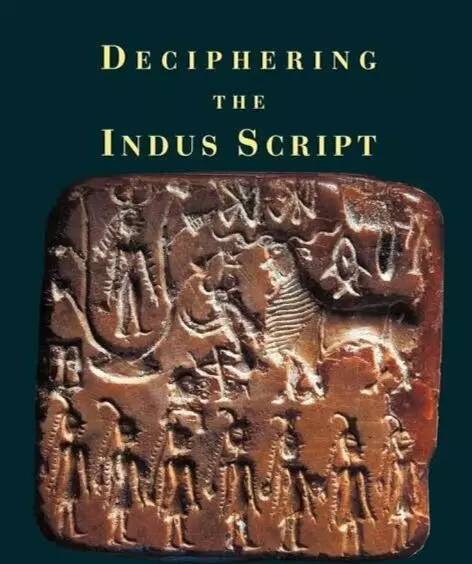Deciphering the Indus Script: Humanity's Oldest Missed Call

In 1959, a young Russian engineer named Yuri once accidentally triggered an entire metro station’s evacuation in Moscow. All he did was sit on a bench, casually munching on a loaf of black bread, and forgetfully leave his toolbox beside him. A vigilant commuter mistook it for a spy’s explosive device, sparking mass panic. By the time Yuri returned, the metro was shut down, security forces swarmed the scene, and his bread had gone stale.
But, in year 2025, in what can only be described as the most peculiar lottery since we would have won after selling the land that our forefathers never bought, Tamil Nadu has announced a reward of one million mother american dollars for the decipherment of humanity's most obstinate puzzle: the Indus Valley script.
What’s the connection between Yuri’s loaf of bread? Much like that abandoned toolbox, the Indus script has been sitting in plain sight for millennia, sparking intrigue, confusion, and a flurry of academic activity. And just as Yuri eventually retrieved his box to reveal nothing more than a few rusty tools, one wonders if the script might reveal something shockingly mundane—like an ancient to-do list or inventory of grains.
One cannot help but draw parallels between this ancient conundrum and the equally baffling phenomenon of modern youth communication. Where once we struggled with hieroglyphics and cuneiform, we now find ourselves utterly confounded by what the young ones call "txt spk." Indeed, one might argue that "C u l8r m8" bears a striking resemblance to certain Indus Valley inscriptions, both in their brevity and their absolute resistance to interpretation by anyone over the age of five-and-thirty.
Chief Minister M.K. Stalin (no relation to the notorious Russian Grandpa and catalyst for the magnificent Moscow metro) has set forth this magnificent sum with the enthusiasm of Rohit Shetty directing a car explosion scene. The announcement, coinciding with the centenary celebrations of the civilization's discovery, has caused more excitement in academic circles than the time Professor Sharma's prized dancing peacock was caught performing bharatanatyam with the department's collection of Ashoka edicts.
The challenge itself appears more formidable than convincing an autowallah to use the meter during peak hours. Each contestant must submit their decipherment methodology to an expert panel comprising archaeologists, linguists, and that one uncle who claims he can read tomorrow's newspaper. The panel will evaluate submissions with the same scrutiny that Indian mothers apply to their children's exam marks.
The Indus Valley civilization, which flourished between 3300 BCE and 1300 BCE (rather precise dating for a culture that couldn't be bothered to leave us a proper instruction manual), has left behind a veritable treasure trove of inscriptions. These tantalizingly brief messages – averaging five signs each – are rather like attempting to deduce the plot of "War and Peace" from a collection of telegraph messages sent by a particularly laconic Russian count.
The similarities between Tamil and Indus Valley cultures are, we are told, quite remarkable. Both buried their dead, tamed bulls (rather than attempting to reason with them), and created pottery. One might as well declare Mumbai and Delhi identical because both cities feature traffic and occasional bouts of political drama.
Recent archaeological discoveries have revealed that 90% of the pottery markings found in Tamil Nadu bear an uncanny resemblance to those of the Indus Valley. This is rather like discovering that great Chef Ranveer Brar's recipe for butter chicken perfectly matches the one used at The Moti Mahal. The Chief Minister has emphasised these connections with the enthusiasm of a Shark Tank India judge discovering a profitable startup.
The establishment of a research chair named after archaeologist Iravatham Mahadevan (with a grant that would make even the most stoic museum curator weep with joy) suggests that Tamil Nadu is quite serious about this endeavour. One imagines ambitious scholars already dusting off their magnifying glasses and preparing to spend the next decade squinting at pottery shards with the intensity of an aunty examining wedding jewelry.
The competition rules are stricter than a South Delhi housing society's pet policies. Contestants must provide comprehensive translations, defend their methodology against peer review, and possibly explain why they weren't doctors or engineers instead. The deadline? "Sometime before the next Indus Valley civilization emerges," quipped an anonymous official.
The challenge of decipherment has thus far proved more difficult than buying Chole Bhature at Chache Di Hatti in North Campus. Over 100 attempts have been made since the 1920s, each ending with the success rate of a seat on the Yellow Line at office commute hours (any time). The absence of a convenient Rosetta Stone-type object (the archaeological equivalent of a parent's translation of teenage slang) has left scholars worldwide in a state of perpetual bewilderment.
One can only imagine the scene in universities across the globe: distinguished professors abandoning their afternoon chai to pore over ancient symbols, possibly while muttering "Eureka!" in increasingly desperate tones. The prize money has transformed what was once a dignified academic pursuit into something akin to an episode of "Kaun Banega Crorepati?" – except the phone-a-friend lifeline has been dead for approximately 4,000 years.
Should anyone succeed in this venture, one hopes the decoded messages prove worth the effort. It would be rather disappointing to discover that the most puzzling inscription merely reads "Out to lunch, back in 5 minutes" or "Beta, why aren't you married yet?" Though perhaps, in its way, such mundane messages would be the most human discovery of all.
In the meantime, we shall watch with great interest as scholars worldwide attempt to crack this ancient code. One rather hopes it doesn't turn out to be an elaborate practical joke by our ancestors, though that would explain why they limited their messages to five characters – rather like prehistoric Twitter, but with better penmanship.
Until then, we can only marvel at the peculiar symmetry of our modern predicament: while our ancient forbears left us messages we cannot read, our contemporary youth send us messages we cannot comprehend. Plus ça change, plus c'est la même chose, as our Pondi friends might say they say.
For now, the prize stands as tantalizing as free WiFi in a coffee shop, beckoning scholars worldwide to attempt what generations before them could not. Perhaps the answer lies not in the stars, but in the next viral Instagram reel.
